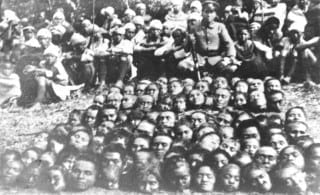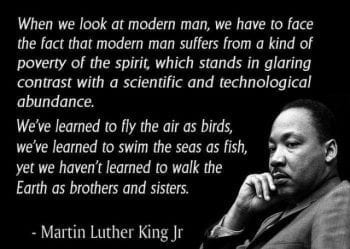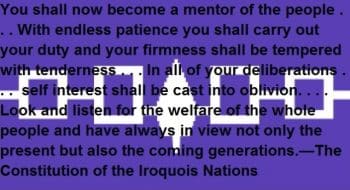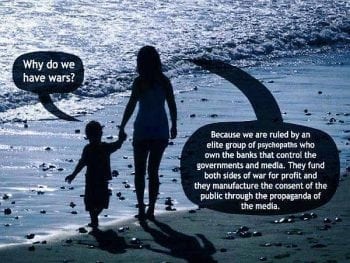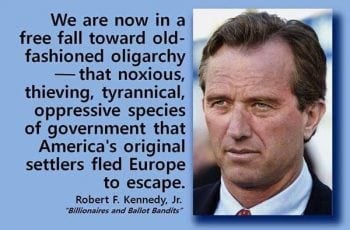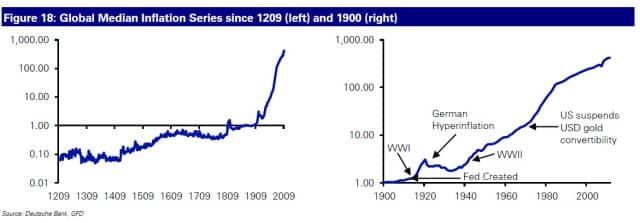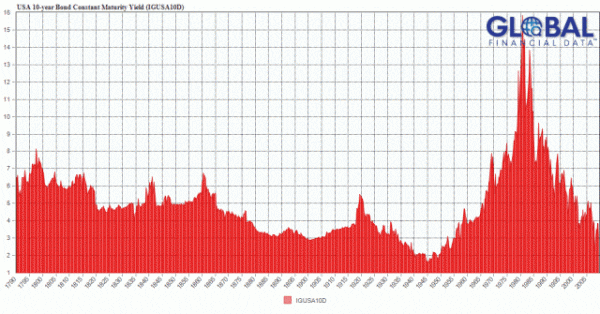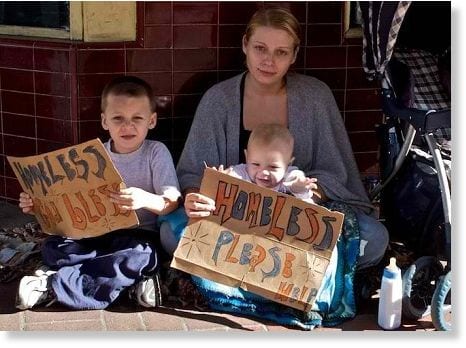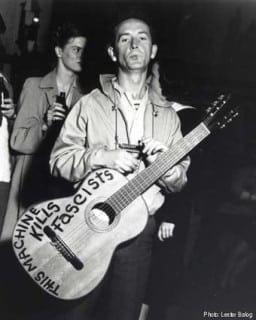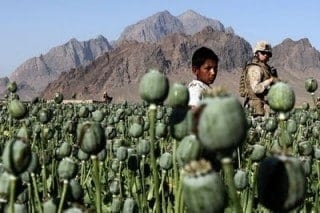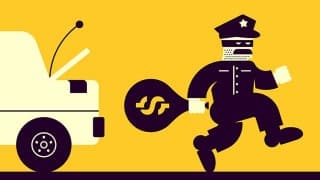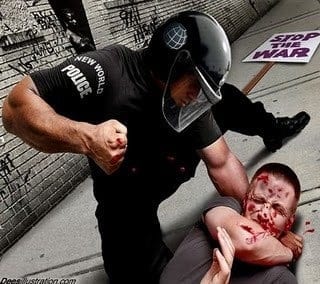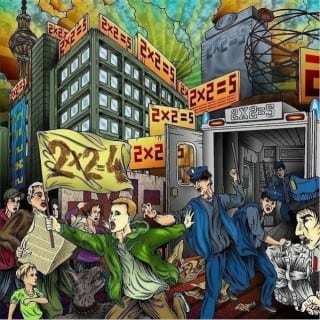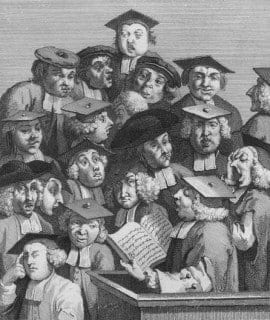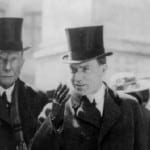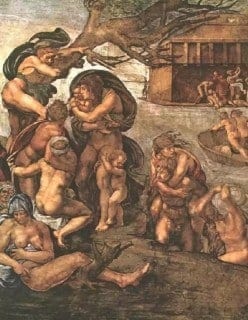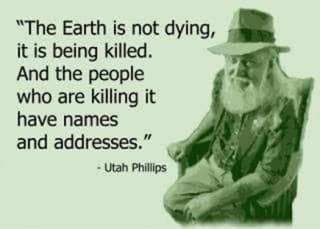![]() Moti Nissani, PhD
Moti Nissani, PhD
No Planet – No People
“The issue which has swept down the centuries, and which will have to be fought sooner or later, is the people versus the banks.”—John Acton (1834-1902) “Unlike Presidents Lincoln, Garfield, and Kennedy, who defied private bankers and were assassinated—Andrew Jackson survived his assassination attempt. . . . Murders of outspoken presidents, who denounced profiteering bankers, have happened too often for them to be explained away as ‘mere coincidences.’”—Jeff Badyna [1, p. 83]![]()
Part III of: Why does the Invisible Government Continue to Grow in Strength?
Yes, as through this world I’ve wandered
I’ve seen lots of funny men
Some will rob you with a six-gun
And some with a fountain pen.And as through your life you travel
Yes, as through your life you roam
You won’t never see an outlaw
Drive a family from their home.—Woody Guthrie
***
Note: If you are not in a position to read this long article, you can get the general picture by reading the following two brief sections (i) summary (below) and (ii) parting words (at the end).
Another shortcut is a recent Radio Sinoland interview:
***
Summary: A successful revolution against tyrants presupposes familiarity with the tyrants’ arsenal. Earlier articles analyzed a few weapons in this arsenal: Sunshine Bribery, Cloak-and-Dagger, Contrived Terror, False-Flag Operations, Absence of Real Democracy, and the Conspiracy Theory Bogeyman. That massive arsenal, in turn, points to just one promising revolutionary strategy. The present article explores an additional weapon in this stupendous arsenal: banking. To begin with, we live now in an upside-down world of perpetual war, tyranny, injustice, materialism, selfishness, starvation, monstrous income inequalities, and ever-growing prospects of human extinction. But this, by itself, constitutes a paradox, because our planet can comfortably provide a decent life for every soul on it. The chaos and suffering must therefore be traced, at least in part, to our rulers.
The ruling clique controlling the U.S., U.K., and most other countries in the world is probably made up of billionaires, generals, and spooks. The best guess is that, at the apex of the pyramid of power and riches, there resides a handful of banking families (bankers for short) dedicated to an inter-generational project of enslaving, and perhaps even exterminating, humanity. We have been warned repeatedly over the centuries that, sooner or later, humanity will have to wage an all-out war on these villainous bankers. A brief history of Central Banking shows that in their war against us, the bankers have not only relied on mind control, human failings, co-option, sunshine bribery, rigged elections, contrived terror, and false flag operations, but that they often murdered influential opponents and just about anyone else who could possibly impede their project of world domination.
Originally, the bankers acquired wealth through the fractional reserve scam. This in turn gave rise to numerous other scams, hoaxes, and machinations, needlessly dragging us to wars, fascism, poverty, helplessness, massive transfer of wealth from the people to the bankers, declining health, and a probable environmental catastrophe. Our first post-revolutionary act ought to involve the utter, irreversible, disempowerment of the banking cabal and—as the framers of the American Constitution intended—entrusting the vital function of coining and issuing money to none other than the people themselves.
***
The World We Live in Today
The bankers and their predecessors in power have managed the seemingly impossible: Manipulating us into acceptance of a “terrible normality.” Michael Parenti: [2]
“Through much of history the abnormal has been the norm. This is a paradox to which we should attend. Aberrations, so plentiful as to form a terrible normality of their own, descend upon us with frightful consistency.
“The number of massacres in history, for instance, is almost more than we can record. There was the New World holocaust, consisting of the extermination of indigenous Native American peoples throughout the western hemisphere, extending over four centuries or more, continuing into recent times in the Amazon region. . . .
“There was the slaughter of more than half a million socialistic or democratic nationalist Indonesians by the U.S.-supported Indonesian military in 1965, eventually followed by the extermination of 100,000 East Timorese by that same U.S.-backed military.
“Consider the 78-days of NATO’s aerial destruction of Yugoslavia complete with depleted uranium, and the bombings and invasion of Panama, Grenada, Somalia, Libya, Yemen, Western Pakistan, Afghanistan, and now the devastating war of attrition brokered against Syria. And as I write (early 2013), the U.S.-sponsored sanctions against Iran are seeding severe hardship for the civilian population of that country. . . .
“Let us not overlook the ubiquitous corporate corruption and massive financial swindles, the plundering of natural resources and industrial poisoning of whole regions, the forceful dislocation of entire populations, the continuing catastrophes of Chernobyl and Fukushima and other impending disasters awaiting numerous aging nuclear reactors.
“The world’s dreadful aberrations are so commonplace and unrelenting that they lose their edge and we become inured to the horror of it all. ‘Who today remembers the Armenians?’ Hitler is quoted as having said while plotting his ‘final solution’ for the Jews. Who today remembers the Iraqis and the death and destruction done to them on a grand scale by the U.S. invasion of their lands? William Blum reminds us that more than half the Iraq population is either dead, wounded, traumatized, imprisoned, displaced, or exiled, while their environment is saturated with depleted uranium (from U.S. weaponry) inflicting horrific birth defects.
“What is to be made of all this? First, we must not ascribe these aberrations to happenstance, innocent confusion, and unintended consequences. Nor should we believe the usual rationales about spreading democracy, fighting terrorism, providing humanitarian rescue, protecting U.S. national interests and other such rallying cries promulgated by ruling elites and their mouthpieces.
“The repetitious patterns of atrocity and violence are so persistent as to invite the suspicion that they usually serve real interests; they are structural not incidental.”
A Better World is Possible
Author Jack Finney asks: “We live on a planet well able to provide a decent life for every soul on it, which is all ninety-nine of a hundred human beings ask. Why in the world can’t we have it?”
The few extant non-captive textbooks of ecology or economics confirm Finney’s observation. We can, if we wish, create, here on earth, a paradise of prosperity, justice, peace, freedom, and sustainability.
Likewise, R. Buckminster Fuller correctly points out that our dreams for a better world are being deferred by choice, not by necessity:
“It is now highly feasible to take care of everybody on Earth at a higher standard of living than any have ever known. It no longer has to be you or me. Selfishness is unnecessary. War is obsolete. It is a matter of converting the high technology from weaponry to livingry.”
Steven Sieden goes on to summarize Fuller’s realizable utopia:
“Weaponry to livingry is the solution to all humankind’s current problems here on our tiny, fragile Spaceship Earth. It’s just that simple. All we need to do is shift a percentage (approximately 40%) of our global military budget from things that take life (weaponry) to things that support life (livingry – food, education, roads, housing, etc.).
“In the 1930’s Bucky Fuller manually made an inventory of all the world’s resources and correctly calculated that we were doing so much more with less resources that we would reach a point when there would be enough to take care of everybody at a higher standard of living than anyone has known. . . .
“It has now been proven that around 1976 we reached the point where there was enough food on Earth to feed everyone. Still, 25,000 people continue to die of starvation every day while a huge percentage of our resources remain focused on weaponry rather than livingry. This is true of all areas of human existence.
“We are living on abundant planet where each of us can have all that we want and need without taking from another. Thus, war and the politics of competition are obsolete. We just need to wake up to the reality of cooperation in which we are all rich beyond our wildest dreams, and everyone can focus his or her time and energy on the things we love so that we may each make our full contribution to others.
“This is Buckminster Fuller’s Universe. It is an abundant Universe in which we all thrive and prosper while supporting a sustainable culture on Spaceship Earth. It is here for us all if we choose to step into it.
“May we all awaken to the abundance that is our birthright while we find and share our most precious gifts and talents.”
So why can’t humanity awaken to its birthright of abundance, sustainability, freedom, and justice? Gordon Gekko and many others point to one of the reasons:
“The US Government – operating today under the control of an international banking cartel – is running a global empire whose sole aim is to exploit the many for the benefit of the few.”
The present article throws some additional light on the fraudulent and vicious methods employed by this Cartel to achieve its goals. It also highlights a few practical consequences of life in a system “whose sole aim is to exploit the many for the benefit of the few.”
A Sampler of Quotations Suggesting that the Issue which has Swept down the Last Three Centuries and which Must be Fought Soon is the People Vs. the Banks
Why indeed, can’t we have a decent life? One part of the answer is surely this: the handful of bankers who parasitize humanity are content to sacrifice our happiness, our health, our spirituality, our ability to think critically and holistically, even our future existence, to achieve their spiteful goals of riches and power for themselves and destitution and subjection for us.
This is not a minority view, but a view that is held by many—by the perpetrators themselves, as well as by many disinterested defenders of the public interest. Here then is a sampler of warnings, sweeping down the centuries.
“I believe that banking institutions are more dangerous to our liberties than standing armies.”—Thomas Jefferson
“My zeal against those institutions was so warm and open at the establishment of the [privately-owned] Bank of the United States that I was declared a maniac by the tribe of bank mongers who were seeking to filch from the public their swindling and barren gains.”—Thomas Jefferson
William Pitt, Chancellor of the Exchequer, said of the inauguration of the first National Bank in the United States under Alexander Hamilton, ”let the American people go into their debt-funding schemes and banking systems, and from that hour their boasted independence will be a mere phantom.”
“History records that the money changers have used every form of abuse, intrigue, deceit, and violent means possible to maintain their control over governments by controlling money and its issuance.”—James Madison
“If the American people only understood the rank injustice of our money and banking system, there would be a revolution before morning.” —Andrew Jackson, cited in Brown [3, p. 74)
“By an iniquitous money system we have nationalized a system of oppression which, though more refined, is not less cruel than the old system of chattel slavery.” — Horace Greeley, editor, congressman, and presidential candidate
“The Government should create, issue, and circulate all the currency and credits needed to satisfy the spending power of the Government and the buying power of consumers. By the adoption of these principles, the taxpayers will be saved immense sums of interest. Money will cease to be master and become the servant of humanity.” —President Abraham Lincoln
“The money power preys upon the nation in times of peace and conspire against it in times of adversity. It is more despotic than a monarchy, more insolent than autocracy, and more selfish than bureaucracy. It denounces as public enemies all who question its methods or throw light upon its crimes. I have two great enemies, the Southern Army in front of me and the bankers in the rear. Of the two, the one at my rear is my greatest foe.”—President Abraham Lincoln
“There in the White House that fateful December [1913] evening, President Wilson signed away the last veneer of control over the American money supply to a cartel; a well-organized gang of crooks so successful, so cunning, so well-hidden that even now, a century later, few know of its existence, let alone the details of its operations. So what, precisely, did this conclave of conspirators devise at their Jekyll Island meeting? A plan for a central banking system to be owned by the banks themselves, a system which would organize the nation’s banks into a private cartel that would have sole control over the money supply itself. . . . The Bank of England in 1694 is the creation of a template that will be repeated in country after country around the world: a privately controlled central bank lending money to the government at interest, money that it prints out of nothing. And the jewel in the crown for the international bankers that created this system is the future economic powerhouse of the world, the United States. In many important respects, the history of the United States is the history of the struggle of the American people against the bankers.” —James Corbett [4]
“A great industrial nation is controlled by its system of credit. Our system of credit is privately concentrated. . . . We have come to be one of the worst ruled, one of the most completely controlled and dominated Governments in the civilized world, no longer a Government by free opinion, no longer a Government by conviction and the vote of the majority, but a Government by the opinion and duress of a small group of dominant men.”—President Woodrow Wilson
[The banking Syndicate is a] “giant octopus that seizes in its long powerful tentacles our executive officers, our legislature bodies, our schools, our courts, our newspapers, and every agency created for pubic protection.”—New Your mayor John Hylan writing in the 1920s“People who will not turn a shovel full of dirt on the project [Muscle Shoals Dam] nor contribute a pound of material, will collect more money from the United States than will the People who supply all the material and do all the work. This is the terrible thing about interest . . . But here is the point: If the Nation can issue a dollar bond it can issue a dollar bill. The element that makes the bond good makes the bill good also. The difference between the bond and the bill is that the bond lets the money broker collect twice the amount of the bond and an additional 20%, whereas the currency, the honest sort provided by the Constitution pays nobody but those who contribute in some useful way. It is absurd to say our Country can issue bonds and cannot issue currency. Both are promises to pay, but one fattens the usurer and the other helps the People. If the currency issued by the People were no good, then the bonds would be no good, either. It is a terrible situation when the Government, to insure the National Wealth, must go in debt and submit to ruinous interest charges at the hands of men who control the fictitious value of gold. Interest is the invention of Satan.”—Thomas A. Edison
“The real truth of the matter is, as you and I know, that a financial element in the larger centers has owned the Government ever since the days of Andrew Jackson.” —President Franklin Delano Roosevelt, 1933
“The people I have called the ‘money changers in the Temple’ are still in absolute control. It will take many years and possibly several revolutions to eliminate them.”—President Franklin Delano Roosevelt, 1934
“I am convinced that the agreement [Bretton Woods] will enthrone a world dictatorship of private finance more complete and terrible than an Hitlerite dream. It offers no solution of world problems, but quite blatantly sets up controls which will reduce the smaller nations to vassal states and make every government the mouthpiece and tool of International Finance. It will undermine and destroy the democratic institutions of this country–in fact as effectively as ever the Fascist forces could have done–pervert and paganise our Christian ideals; and will undoubtedly present a new menace, endangering world peace. World collaboration of private financial interests can only mean mass unemployment, slavery, misery, degradation and financial destruction. Therefore, as freedom loving Australians we should reject this infamous proposal.”—Eddie Ward, Australian Labor Minister
“Professor Quigley wrote from personal knowledge of an elite clique of global financiers bent on controlling the world. Their aim, he said, was ‘nothing less than to create a world system of financial control in private hands able to dominate the political system of each country and the economy of the world as a whole’. . . . Their essence was . . . just a passion for control over other humans. The key to their success was that they would control and manipulate the money system of a nation while letting it appear to be controlled by the government.’”—Cited in Brown [3, pp. 1- 2]
“Every Congressman, every Senator knows precisely what causes inflation . . . but can’t support the drastic reforms to stop it [repeal of the Federal Reserve Act] because it could cost him his job.”—Robert A. Heinlein
“[The men of the Invisible Government] would continue to grow in strength, until they had the whole silly world, the whole credulous world, the whole ingenuous world, in their hands. Anyone who would challenge them, attempt to expose them, show them unconcealed and naked, would be murdered, laughed at, called mad, ignored, or denounced as a fantasy-weaver.”—Taylor Caldwell [5]
“I have never yet had anyone who could, through the use of logic and reason, justify the Federal Government borrowing the use of its own money. I believe the time will come when people will demand that this be changed. I believe the time will come in this country when they will actually blame you and me and everyone else connected with the Congress for sitting idly by and permitting such an idiotic system to continue.”— Congressman Wright Patman, Chair of the House of Representatives Committee on Banking and Currency
“The banking cartel wrote their own rules and regulations, called it “The Federal Reserve Act,” got it passed into law, and it was very much to their liking because they wrote it. And in essence what they had created was a set of rules that made it possible for themselves to regulate their industry, but they went even beyond that. . . . Congress gave away the sovereign right to issue the nation’s money to the private banks.”—G. Edward Griffin [6]
“The Federal Reserve is an independent agency and that means there is no other agency of government that can overrule actions that we take.”—Alan Greenspan, former chair of the Federal Reserve
“The whole Federal Reserve System was designed to . . . slowly drain the massive wealth of the American people and transfer it to the elite international bankers.—Michael Snyder, 2010
In his 2015 Killing the Host, Professor Michael Hudson “confirms that your ongoing struggle to make ends meet is not a reflection of your lack of talent or drive but the only possible outcome of having a blood-sucking financial leech affixed to your body, your retirement plan, and your economic future. . . . [Wall Street banks have] “become the economy’s central planners, and their plan is for industry and labor to serve finance, not the other way around.”—Cited by Pam Martens
The Fractional Reserve Scam
“In the past, savers looking to [safeguard] their coins and valuables . . . deposited gold and silver at goldsmiths, receiving in exchange a note . . . These notes gained acceptance as a medium of exchange for commercial transactions and thus became an early form of circulating paper money. As the notes were used directly in trade, the goldsmiths observed that people would not usually redeem all their notes at the same time, and they saw the opportunity to invest their coin reserves . . . This generated income for the goldsmiths but left them with more notes on issue than reserves with which to pay them. A process was started that altered the role of the goldsmiths from passive guardians of bullion, charging fees for safe storage, to interest-paying and interest-earning banks. Thus fractional-reserve banking was born.”
Note that this scam involves:
- The goldsmith-turned-banker enriches himself by clandestinely using other people’s money—in this case gold and silver of depositors who gave the banker the coins for safekeeping, not for lending.
- The double-dealing goldsmith not only lends his customers’ gold or silver, but also creates paper certificates for more gold or silver than he has on deposit. Thus, he artificially increases the money supply in circulation. He then receives interest payments on the certificates he has created from nothing.
- Mind control and secrecy are at the very heart of this legalized racket: Would you deposit 10 ounces of gold in a bank for safekeeping, knowing that the bank would then use them to issue gold certificates for 50 or more ounces? Would you deposit a single gram of gold with the bankers knowing that your gold would be safer in your back yard? With transparency and a free market of ideas, the system would collapse soon enough. That is the meaning of Henry Ford’s famous aphorism: “It is well enough that people of the nation do not understand our banking and money system, for if they did, I believe there would be a revolution before tomorrow morning.”
- By increasing the total supply of money in circulation, the fractional reserve system tends to keep the prices of gold and silver lower than they would otherwise be.
- This fractional shell game causes systemic instability. If more than, say, 20% of depositors in any bank tried to retrieve their money on the same day, chaos will ensue.
- The heart of of this fractional flim-flam—and the reason it is almost universally adopted—is that it enriches its practitioners and impoverishes the vast majority.
To see this last point, imagine a self-contained planet consisting 101 prosperous citizens, of which one is a banker. At the moment the law legalizing fractional reserve banking is passed, each citizen is the proud owner of a home and $10,000. All citizens keep their money with the banker, using checkbooks to make purchases. The banker now has free access to $1,000,000 of other people’s money.
Now Shevek needs a loan of $300,000 to work on his invention of faster-than-light travel. The banker approves the loan, creates entries in his computer, and writes Shevek a check. The loan pays a modest 2% annual interest, with Shevek’s house serving as collateral. Note that this new money, fraudulently created out of thin air as debt, is in reality counterfeit money legally entering into circulation. At this point, the money supply on the planet is almost 30% larger than it was before Shevek received his loan.
One can imagine several possible outcomes.
First, Shevek’s invention worked and he returns the money after 5 years. The $300,000 which were a computer entry to begin with, now vanish, and the island’s money supply goes back to one million. But, and this is the key point: Shevek also pays the banker compound interest, which in this case is a bit over $31,000. Where did this money come from? Since the real money supply is fixed at $1 million, the $31,000 must have come from the citizens of that planet. Before Shevek took the loan, the banker had just under 1% of all the money on the planet, and his fellows held, collectively, over 99%. At the end of 5 years, the banker has almost 4% and his fellows are down to 96%.
The banker can choose to compensate the reduction in the money supply by simply printing $31,000. In that case, the outcome is roughly the same (the citizens lose and he gains), owing to inflation.
The other possible outcome of this sucker game is that Shevek fails and the banker repossesses Shevek’s home. The banker then sells the house for $100,000, and income distribution on that planet suffers an even worse blow than it did with the other options.
You let this con game go on for a while, and the banker will own everyone and everything on the planet. That is why one of the biggest buildings of many a city is a bank—even though banks produce nothing of value. That is also how bankers can buy politicians, journalists, book writers, generals, spooks, foreign leaders, ordinary citizens, and assassins.
The only way to stop this racket is to deprive private banks and privately-controlled central banks of the power to create money. When the process of fraudulent accumulation of money and power in few hands has gone too far, when the parasitic producers of nothing achieve their goal of owning almost everything and everyone, the people become slaves, revolutionaries, or residents of a failed state.
After enriching themselves with the goldsmith fractional reserve shell game, the bankers proceeded to use their ill-gotten profits to gain control of entire nations. According to Ellen Brown [3, p. 66], the outlines of the privately-controlled central bank game of loaded dice were first worked out in 1694, in England. Then and ever since, this game involved:
- Establishment of a central bank in charge of issuing and circulating the national paper currency.
- The currency is created out of nothing (thus institutionalizing the fractional reserve banking golden goose, where you can lend a lot more money than you yourself have or that your customers have on deposit at your bank). That funny money can then be lent to the government. The government’s indebtedness to the bank now backs up the additional loans that the bank would make to private parties.
- The government pays the bank interest on all loans it receives from the bank. The government must, by definition, go into debt.
- To secure payments on the national debt, the people are more heavily taxed. Largely because of interest payments, England national debt by 1698 was 13 times higher, and by 1815 it was 737 times higher, than what it was in 1694.
- The owners of the central bank “not only reaped huge profits, but the indebtedness gave them substantial political leverage.”
These were the blueprints for all subsequent clones of the Bank of England, including America’s Federal Reserve Syndicate. Once you strip banking jargon to its essence (as Brown and many others have done), an alternative is immediately obvious: In a country where an honest government itself controls the coining and issuing of money, the people prosper.
Adrian Kuzminski argues that the modern financial system is inherently exploitative and destructive:
“The modern economy functions on the self-defeating principle of exponential growth . . . [driven by] the current financial system. . . . For the first time in history a fateful imperative to growth—and exploitation—was built right into the economy. . . . The system has plateaued, for the moment, but having been designed for endless exponential growth, not for a steady state, it is destined to unravel. . . . Our financial system is a relatively recent invention, devised by clever, selfish men for their personal gain. It is not the product of any natural or inevitable process, nor of democratic deliberation. It is a scam. We need not be stuck with it, and the sooner we rid ourselves of it the better.”
A Century of Purse-Snatchings, Smears, and Assassinations
“If you had the privilege of creating dollars from thin air, and loaning them to government at interest, you might do anything to protect that privilege.”—Rand Clifford
There is a great deal at stake then, in the one-sided war of the bankers against the people—for the bankers and for the people. So it should come as no surprise that since 1,694 that war shaped world history.
Indeed, as one century gave rise to another, the international bankers relied on conspiracies, needless wars, bribes, mind control, smears, and assassinations, to steadily deprive us of our wealth and liberties. Here are a few highlights and casualties of that long war.
Thomas Jefferson. During the early post-revolutionary period, the bankers’ war against the people included, for instance, the feud between Alexander Hamilton, possibly a Rothschild agent, and Thomas Jefferson.
Jefferson died of old age.
Andrew Jackson. In the 1830s, the conspicuous warriors were Nicholas Biddle, president of the then private central bank of the United States and perhaps serving the Rothschilds, and President Andrew Jackson, representing ordinary Americans (of European descent only, unfortunately). Jackson won, abolished the bank (one of the privately-owned Federal Reserve Syndicate’s predecessors), and consequently was the last president to fully pay America’s national debt.
When asked: “What was your proudest accomplishment as President?” Jackson Replied: “I killed the bank.” [1]
Jackson knew he would be targeted. In 1832, he said to his vice president: “The bank, Mr. Van Buren, is trying to kill me.” And tried they did. Jackson miraculously survived an assassination attempt by the bankers’ then favorite approach: a lone gunman.
President Abraham Lincoln. “The 1863 National Banking Act [7] reinstated a private US central bank and Chase’s war bonds were issued. Lincoln was re-elected the next year, vowing to repeal the act after he took his January 1865 oaths of office. Before he could act, he was assassinated at the Ford Theatre by John Wilkes Booth. Booth had major connections to the international bankers. His granddaughter wrote This One Mad Act, which details Booth’s contact with ‘mysterious Europeans’ just before the Lincoln assassination. . . . Booth was . . . connected through Confederate Secretary of State Judah Benjamin to the House of Rothschild.”
President James Garfield. In 1881, “the American people elected the Republican, James Garfield, as the 20th President of the United States. This was a worry to the moneychangers, because as a Congressman, he had been Chairman of the Appropriations Committee, and was a member of Banking and Currency. The money changers were therefore aware that President Garfield was in full knowledge of their scam on the American people.”
Following his inauguration, President Garfield stated,
“Whosoever controls the volume of money in any country is absolute master of all industry and commerce. . . And when you realize that the entire system is very easily controlled, one way or another, by a few powerful men at the top, you will not have to be told how periods of inflation and depression originate.”
Naturally, within a few weeks of making that statement, President Garfield was shot by a lone gunman. “Actually, Garfield was definitely killed by his doctors probing for bullet; he would have completely recovered otherwise.”
As a result of the murder, the bankers got their way: “Depression deepened, leaving masses of unemployed to face poverty and starvation at a time when there was no social security or unemployment insurance to act as a safety net. Produce was left to rot in the fields, because there was no money to pay workers to harvest it or to buy it when it got to market. The country was facing poverty amidst plenty, because there was insufficient money in circulation to keep the wheels of trade turning.” [3, p. 94]
President William McKinley. “President McKinley began his attack against e Central Bankers with Secretary of State John Sherman (1823-1900). They used the “Sherman Antitrust Act” against the Rothschild supported and funded JP Morgan financial empire known as the Northern Trust, which by the late 1800s owned nearly all of America’s railroads.” [8]
McKinley’s fight against the Central Bankers ended with his assassination in 1901. (As in the case of Garfield, he was shot by a lone assassin and then given the final blow by his doctors, again proving the aphorism that, with conventional medicine, the patient often dies of the cure.)
David Graham Phillips. By the early 1900s, the bankers had nearly accomplished their dream of enslaving the American people. They did this in part by continuing to buy the nation’s newspapers and molding public opinion, in part through brilliant long-term strategies and conspiracies, in part by bribing just about every politician and judge in the land, and in part by applying the clock-and-dagger approach to anyone who wouldn’t bend to their will.
Thus, by 1906, American politics and commerce were a cesspool of corruption and nepotism. It was then that David Graham Phillips published his sensational “Treason of the Senate:” [9]
“The treason of the Senate! Treason is a strong word, but not too strong, rather too weak, to characterize the situation in which the Senate is the eager, resourceful, indefatigable agent of interests as hostile to the American people as any invading army could be, and vastly more dangerous; interests that manipulate the prosperity produced by all, so that it heaps up riches for the few; interests whose growth and power can only mean the degradation of the people, of the educated into sycophants, of the masses toward serfdom. . . . For the organizer of this treason [against the American people’] we must look at Nelson W. Aldrich, senior senator from Rhode Island.”
“As a result of these articles, only four of the twenty-one senators that Phillips wrote about were still in office.” In particular, Phillips’ Exposé cost Nelson Aldrich, John D. Rockefeller Sr.’s son-in-law and one of the seven original 1910 Jekyll Island conspirators, his Senate seat.
Phillips was murdered in 1911, aged 43, allegedly by a lone, deranged, gunman. Among other bizarre aspects of this case, one stands out: the alleged assassin brandished a single six-shooter (a revolver that can only fire six bullets without being re-loaded). He lodged 6 bullets in Phillips’ body—and then, without re-loading, killed himself with a mysterious seventh bullet (an earlier version of JFK’s magic bullet?) [10]
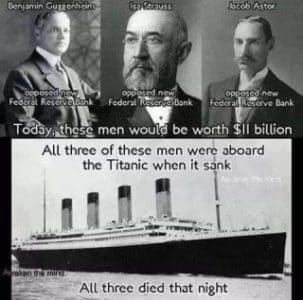 John Jacob Astor IV, Benjamin Guggenheim, and Isador Strauss. We move on to the very convenient simultaneous death of three American tycoons. All three were aboard the Rothschild/Morgan-owned Titanic when it sank in 1912, a year before the creation of the Federal Reserve Syndicate. All three opposed that creation —and were perhaps powerful enough to torpedo it.
John Jacob Astor IV, Benjamin Guggenheim, and Isador Strauss. We move on to the very convenient simultaneous death of three American tycoons. All three were aboard the Rothschild/Morgan-owned Titanic when it sank in 1912, a year before the creation of the Federal Reserve Syndicate. All three opposed that creation —and were perhaps powerful enough to torpedo it.
Among the many other bizarre aspects of the sinking of the Titanic, there is a strange list of mysterious last-minute cancellations: 1. Morgan himself was scheduled to travel on the maiden voyage of his ship but opted out at the last moment. 2. Tycoon Milton Snavely Hershey had to cancel his passage because “business back home apparently intervened.” 3. Morgan’s business associate, Pittsburgh Steel Baron Henry Clay Frick, was likewise miraculously saved from drowning by canceling his passage at the last moment because “his wife sprained her ankle.” 4. Tycoon Alfred Gwynne Vanderbilt canceled his passage on the Titanic so late that some early newspaper accounts listed him as being on board (he would receive the same late warning before traveling on the Lusitania—which he mysteriously chose to ignore).
This is neither the first nor the last time that fortune smiles on the bankers’ friends—and frowns upon their enemies.
Congressman Charles Lindbergh. Although by the beginning of the 20th century the bankers were fully in control of America, they were still concerned about a populist movement that might deprive them of that power. They decided therefore to formalize their control by establishing yet another Central Bank of the USA, which they—and not the people—would control. To do this, they engaged in one of the wiliest conspiracies of all time. In 1910, seven of them secretly met in Jekyll Island, off the coast of Georgia, to finalize their takeover of the USA. Later, by coaxing former president Teddy Roosevelt to run on a third party platform, they saw to it that their lackey—Woodrow Wilson—was elected president. To put the wool over the eyes of the people and even such naive people’s champions as William Jennings Bryan, they pretended that they, themselves, were opposed to their own bill. The heinous bill passed in 1913.
The most influential, astute, honest, and capable opponent of the bankers in those years was Charles Lindbergh (father of the famous aviator).
In 1913, for instance, Lindbergh wrote [11]:
“The financial system has been turned over to the Federal Reserve Board. That board administers a finance system by authority of a purely profiteering group. That system is private, conducted for the sole purpose of obtaining the greatest possible profits from the use of other people’s money. This (Federal Reserve) Act establishes the most gigantic trust on Earth. When the president signs this bill, the invisible governments by the monetary power will be legalized. The people may not know it immediately but the day of reckoning is only a few years removed, the worst legislatives crime of the ages perpetrated by this banking bill.”
Lindbergh died in 1924, aged 65, following a vicious smear campaign and assassination threats.
His grandson and namesake died in 1932, aged 20 months, in a so-called crime of the century.
“Police charged Bruno Richard Hauptmann with the hacking to death of this toddler. Although Hauptmann continued to adamantly maintain his innocence, all his appeals and petitions for clemency were rejected by early December 1935. Despite a last minute attempt by New Jersey Governor Harold G. Hoffman (who believed Hauptmann was guilty but also had always expressed doubts that he could have acted alone) to convince him to confess to the crimes in exchange for getting his sentence commuted to life imprisonment, the by then 36-year old Hauptmann refused and was electrocuted at Trenton State Prison on April 3, 1936.”
Later scholarship provides additional confirmation of Hauptmann’s innocence. [12]
Senator Huey Long. “Wouldn’t you like to vote for a guy that was hated by big business, hated by the 1 percent, hated by Wall Street? Wouldn’t you like the chance to vote for someone who was willing to take them all on; someone who’d promise to re-regulate the system and tax the hell out of every billionaire fatcat in America?”[13] Wouldn’t you indeed vote for someone brave enough to fight the Rockefellers—and temporarily defeat them?
Long, a popular ex-governor, senator, and a promising presidential hopeful, was adamantly opposed to the Federal Reserve Syndicate, foreign wars, and needless poverty side by side with massive concentration of wealth in a few hands. “Long argued there was enough wealth in the country for every individual to enjoy a comfortable standard of living, but that it was unfairly concentrated in the hands of a few millionaire bankers, businessmen and industrialists.”
Huey Long was shot and killed by a lone gunman in 1935.
General Smedley Butler and President Franklin Delano Roosevelt (FDR). Franklin Delano Roosevelt was a member of the ruling class and certainly sympathetic to its interests. But he also wished to mitigate the sufferings and deaths caused by the (bankers-engineered) Great Depression. This led the bankers to attempt his removal from office through a fascist coup. But they were still finding their way in those days, as shown by the aborted assassination of President Jackson—and the almost-failed assassinations of President Garfield and McKinley. In this case, their error involved the belief that everyone was corruptible.
To lead the coup, they chose the popular General Smedley Butler. They did this even though they must have known that a year earlier for instance, in 1933, Butler toured the country. . . “trying to educate the soldiers out of the sucker class” and condemning the FDR administration for its ties to big business. . . . He said: “I believe in . . . taking Wall St. by the throat and shaking it up.”
Butler however double-crossed them in 1934, thus postponing the arrival of outright fascism to America’s shores by about half a century.
After single-handedly aborting the Nazi coup, and in addition to cross-country lecturing, Butler served, from 1935 to 1937 as a spokesman for the American League against War and Fascism. By 1935, he wrote the classic exposé War Is a Racket [14], “a trenchant condemnation of the profit motive behind warfare.”
Butler died in 1940, aged 58. FDR died in office in 1945, aged 63.
Luis McFadden, Chairperson of the House Banking Committee. In a 1932 speech in the House of Representative, (the unfortunately bigoted) McFadden said:
“Mr. Chairman, we have in this country one of the most corrupt institutions the world has ever known. . . . The Federal Reserve Board, a Government board, has cheated the Government of the United States and the people of the United States out of enough money to pay the national debt. . . . This evil institution has impoverished and ruined the people of the United States, has bankrupted itself, and has practically bankrupted our Government. It has done this through the defects of the law under which it operates, through the maladministration of that law by the Federal Reserve Board, and through the corrupt practices of the moneyed vultures who control it. . . . The sack of the United States by the Fed[eral Reserve] is the greatest crime in history. Every effort has been made by the Fed to conceal its powers, but the truth is the Fed has usurped the government.”
Ellen Brown sums up the sequel [3, p. 158]:
“As for Congressman McFadden’s impeachment action against the Fed, he never got a chance to prove his case. His investigation was terminated by his sudden death in 1936, under suspicious circumstances. The alleged cause: ‘heart-failure sudden death,’ following a bout of ‘intestinal flue.’ His petition for Articles of Impeachment against the Federal Reserve Board for fraud, conspiracy, unlawful conversion and treason was never acted upon.”
This followed two earlier attempts to take McFadden’s life, the first by shooting and the second by poisoning.
The Kennedy Clan. With the Kennedy family, the hitmen went overboard, suggesting a personal vendetta—in addition to the fact that “Kennedy was the last president to take a real stand against Wall Street . . . the CIA, war, and Israel’s construction of a massive nuclear arsenal.” [3, p. 202] JFK’s older sister Kathleen briefly dated David Rockefeller, and died (1948) in an airplane crash. His older brother Joseph (1944), and his son JFK, Jr. (1999), died in an airplane crash. His younger brother Ted miraculously survived an airplane crash (1964), a car accident (1969), and a vicious smear campaign. JFK (1963) and his younger brother RFK (1968; and likely-to-win presidential aspirant) were shot in broad daylight.
JFK’s widow Jackie married Greek shipping tycoon Onassis, perhaps because she hoped that his wealth and foreign residence would provide a measure of protection for her two children. Her prudence only bought her son time, and probably cost Onassis more than he bargained for (his son died in a 1973 plane “accident”).
Three other outspoken and influential critics of the banking cabal died in three separate airplane crashes: Representative Dr. Larry P. McDonald (died in 1983, aged 48), Senator John Heinz (1991, aged 52), and Senator John Tower (1991, aged 65). Many others were incarcerated, smeared, and assassinated, and will be duly documented in a forthcoming Cloak-and-Dagger Encyclopedia.
Before you dismiss all these mysterious deaths as mere coincidences, recall that, throughout the last 150 years, there were many more bankers’ yes-men in the White House and Congress than there were champions of the people. How many of these yes-men were killed by a lone gunman or in an airplane crash?
This is not the place to play with statistics, but let me assure you that any independent statistician would immediately identify a pattern here—as opposed to chance events. If you drink water contaminated with a specific type of bacterium, you might die of cholera. If you live in a bankers-infected world and you dare oppose the parasites or happen to be in their way, you might die of bankititis. That is the verdict of the historical record (a more comprehensive treatment of assassination patterns is available here [15]).
Throughout this entire period, I can only think of one clear exception to this rule: Congressman Wright Patman.
Many others were incarcerated, smeared, and assassinated, and will be duly documented in a forthcoming Cloak-and-Dagger Encyclopedia. There is, however, one case that deserves special mention because it simultaneously exposes the fractional reserve fraud and the Syndicate’s license to kill and destroy.
The Extraordinary Case of Jerome Daly, Bill Drexler, and Martin Vincent Mahoney
To implement their programs of enslaving humanity, the bankers long ago bought—or scared into submission—the vast majority of the legal profession. Thankfully, a few people are capable of casting self-interest “into oblivion” and looking and listening to “the welfare of the whole people.”
Here is Ellen Brown again:
“First National Bank of Montgomery vs. Daly (1969) was a courtroom drama worthy of a movie script. Defendant Jerome Daly . . . an attorney representing himself, argued that the bank had put up no real money for his loan. The courtroom proceedings were recorded by Associate Justice Bill Drexler . . . Drexler hadn’t given much credence to the theory of the defense, until Mr. Morgan, the bank’s president, took the stand. To everyone’s surprise, Morgan admitted that the bank routinely created money “out of thin air” for its loans, and that this was standard banking practice.
“’It sounds like fraud to me,’ intoned Presiding Justice Martin Mahoney amid nods from the jurors. In his court memorandum, Justice Mahoney stated:
“’Plaintiff admitted that it, in combination with the Federal Reserve Bank of Minneapolis . . . did create the entire $14,000.00 in money and credit upon its own books by bookkeeping entry. . . Mr. Morgan [president of the local bank] admitted that no United States Law or Statute existed which gave him the right to do this.’
“The court rejected the bank’s claim for foreclosure, and the defendant kept his house. To Daly, the implications were enormous. If bankers were indeed extending credit . . . without backing their loans with money they actually had in their vaults, . . . a decision declaring their loans void could topple the power base of the world. He wrote in a local news article:
“’This decision, which is legally sound, has the effect of declaring all private mortgages on real and personal property, and all U.S. and State bonds held by the Federal Reserve, National and State banks to be null and void. This amounts to an emancipation of this Nation from personal, national and state debt purportedly owed to this banking system. Every American owes it to himself . . . to study this decision very carefully . . . for upon it hangs the question of freedom or slavery.’”
The intrepid Daly did not stop there [16]:
“Mr. Daly has also been active on the tax resistance front. He hasn’t paid income taxes since 1965, claiming that the income tax is unconstitutional . . . Daly also ties the claim in with the Minnesota court decision on the unconstitutionality of banks’ issue of fiat money. What Daly does is to submit an income tax return, consisting of over 40 pages of his legal claims, and suggesting that the IRS sue him for the tax in U. S. District Court. So far IRS has not sued Mr. Daly, who is now holding seminars around the country instructing people how to fill out similar income tax forms.”
If you have been paying attention so far, you are in a position to make two predictions:
- Since the bankers own the government (executive, legislative, and judiciary, mass media, and a variety of alphabet soup assassination squads), the decision will have been overturned.
- Since the bankers have a license to kill and destroy, and since that court decision threatened their fractional reserve golden goose, they must make an example of the three main protagonists.
It only took me a few minutes to confirm both predictions.
“The bank appealed the next day, and the decision was ultimately nullified on the grounds that a Justice of the Peace [and a jury representing the American people] did not have the power to make such a ruling.”
Mahoney died at age 54, less than six months after the trial. Bill Drexler, Mahoney’s associate justice, explained in 2005: [17] “The money boys that run the ‘private Federal Reserve Bank’ soon got back at Mahoney by poisoning him in what appeared to have been a fishing boat accident (but with his body pumped full of poison) in June of 1969, less than 6 months after the trial.”
Daly and Drexler were comparatively lucky: Both were disbarred by the highest (kangaroo) court of the State of Minnesota.
The Impact of the Federal Reserve Syndicate on the USA and the World: A Sampler
The bankers have played a destructive role in American history, always achieving their goals through a combination of clandestine conspiracies, control of information sources, controlled elections, bribery, intimidation, smears, imprisonment, and assassinations.
In the UK as well, the same financiers enjoy near-total control of every aspect of that nation’s life—a control that is much more visible and codified into law than in the US. An article in one of the bankers’ chief propaganda organs underscores the in-your-face rule of the bankers.
“Governed either by or on behalf of the people who fleece us, we cannot be surprised to discover that all public services are being re-engineered for the benefit of private capital. . . . The financial sector exploits an astonishing political privilege: the City of London [London’s financial district] is the only jurisdiction in the UK not fully subject to the authority of parliament. In fact, the relationship seems to work the other way. Behind the Speaker’s chair in the House of Commons sits the Remembrancer, whose job is to ensure that the interests of the City of London are recognised by the elected members.”
And they dare call it democracy?
To confirm our suspicion that privatized central banks such as the Federal Reserve Syndicate constitute the biggest and riskiest scam in history, we need to ask: What have they accomplished so far, besides fractionally stealing from us, conspiring against us, lording over us, and murdering our champions?
Here then are a few highlights of the bankers’ ongoing (and so far unilateral) war against humanity.
Inflation
One alleged objective of the Federal Reserve Syndicate is stable prices. That is as it should be, for the debasement of currency is one loathsome mechanism of transferring wealth from the vast majority to the bankers and their partners in crime. Inflation also causes economic and political instabilities. At times, it leads to hyperinflation, which causes even more sufferings and instabilities.
The following charts trace the course of global inflation before and after 1913, suggesting that the Syndicate has enriched itself by deliberately betraying its anti-inflationary mandate.
Here is one specific example: Despite manyfold improvements in agricultural productivity over the last century, the same amount of money that bought you 38 potatoes in 1913, buys you now just one.
Unemployment
Full employment constitutes a second major alleged objective of the 1913 Federal Reserve act, again for excellent reasons. First, unemployment is painful. Second, massive unemployment destabilizes the entire politico-economic system. The under-employed and the unemployed can readily imagine a system where both work and leisure are equally shared by all, and they are less likely to be favorably disposed to a system that converts them into a reserve army of outcasts and rebels.
So, after a century of “trying” to achieve maximum employment, where are we?
In 1913, when the Syndicate came into being, unemployment stood at about 6.6%. By 1933—the height of the Syndicate-created Great Depression—it climbed to 35.3%. According to Boris Borisov, unemployment in the USA during the 1930s led to the death of over 7,000,000 Americans (one more genocide in American history, and second only to the deliberate extermination of Native Americans [18]).
After America’s entry into World War II, unemployment precipitously declined.
Throughout the first 15 years of the 21st century, high unemployment seems to have become a structural part of the system—even though the USA has been, throughout those 15 years, on a permanent war footing.
For their part, the bankers and their government lackeys “solve” the high unemployment conundrum by fudging. If we ignore their self-serving lies, damn lies, and statistics, and count the percentage of unemployed [19] as it was done, for instance, in the 1970s, then since 2009, unemployment levels never fell below 20%. By August 2015, they stood at 22.9%.
We can also circumvent the lies of the bankers by noting the record number of adults out of the workforce: 94,000,000 (in 2015).
So, for the past seven years, America has been in the grips of a depression—courtesy of its privately owned, conspiratorially-conceived, banking Syndicate.
Interest Rates
A third formal objective of the Syndicate “is moderate long-term interest rates.” The nearby chart depicts the history of U.S. medium-term interest rates (10-year government bonds), since 1790, again showing a discrepancy between avowed and real goals. For instance, throughout those years, rates have reached their lowest points, by far, after the creation of the Syndicate: in 1945 and in recent years (the September 2015 rate hovers around 2.1%). They reached their highest points, by far, in the early 1980s.
By late 2015, the benchmark Federal Fund Rate (the one rate that is set directly by the Syndicate) has been near zero percent for seven years! That, as you surely realize by now, benefits the bankers and their cronies but distorts market forces and harms ordinary people. Retirees and other savers feel especially betrayed, as the real value of their savings steadily declines.
Poverty and Scandalous Income inequalities
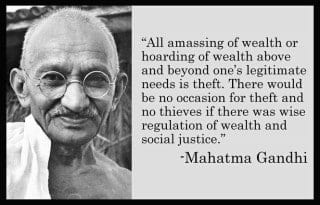 As we have seen, ever-growing income inequalities are at the heart of the fractional reserve system. The rise in productivity, the competition from the old USSR, and the ever-present threat of revolution, occasionally halted or reversed the process. Overall, however, the trend is unmistakable: The Syndicate and its lackeys have achieved one of their key unstated goals: A net transfer of wealth from our coffers to theirs. “At the moment, the top 0.1% (consisting of 160,000 families worth $73 million on average) holds 22% of America’s wealth . . . almost the same share as the bottom 90% of the population.”
As we have seen, ever-growing income inequalities are at the heart of the fractional reserve system. The rise in productivity, the competition from the old USSR, and the ever-present threat of revolution, occasionally halted or reversed the process. Overall, however, the trend is unmistakable: The Syndicate and its lackeys have achieved one of their key unstated goals: A net transfer of wealth from our coffers to theirs. “At the moment, the top 0.1% (consisting of 160,000 families worth $73 million on average) holds 22% of America’s wealth . . . almost the same share as the bottom 90% of the population.”
An article in the bankers’ owned press contains an even stronger indictment:
“The distribution of wealth in the United States is getting absurd . . . The family of Sam Walton, founder of supermarket chain Walmart, has amassed over $149 billion in wealth. The family possesses as much as all of the lowest 42 percent of the country combined.”
For the world as a whole, the situation is even worse:
“At last reckoning, 80 oligarchs own the wealth equivalent of the bottom 3.6 billion people on the planet, billions who must survive on less than $2 per day!” [20]
By now, the bankers openly mock us. Here is an April 2015 conversation between three Rothschild’s employees (all three also were, at one time, U.S. Treasury Secretary). Watch this video clip and gnash your teeth (36:08-36:31):
The key passage:
Paulson: “Ok, well . . . income inequality. I think this is something we’ve all thought about. You know I was working on that topic when I was still at Goldman Sachs.”
Rubin: “In which direction? You were working on increasing it.”
Paulson then bursts out laughing: “Yeah! We were making it wider!”
Income Tax
How would it feel like, living in a world where you no longer have to pay federal taxes, turn a part of your life into a never-ending bookkeeping rigmarole, live in fear of IRS arbitrary harassment, interminably wait for an IRS functionary to pick up the phone? Couldn’t you find some better use for the time and money you now spend on income taxes? How would it feel like knowing that federal taxes could be readily abolished—if we could just get rid of the Syndicate?
According to Ellen Brown [3, p. 3]:
“The federal income tax was instituted [in 1913, the same year the Syndicate was created] specifically to coerce taxpayers to pay the interest due to the banks on the federal debt. If the money supply had been created by the government rather than borrowed from banks that created it, the income tax would have been unnecessary.”
The Gold Heists
There are good reasons to believe that the bankers, operating through their Syndicate and their Treasury Department, stole the American people’s gold twice. First, they confiscated the people’s gold, paid them $20 an ounce, and then raised the price to $35. Next, the descendants of these thieves, most likely [21, 22] simply stole that gold—all 8,044 tons of it—from the American people.
William Engdahl: [22]
“There are grave doubts whether the Federal Reserve actually holds the 8,044 tons of gold it claims it does. The former International Monetary Fund director, France’s Dominique Straus-Kahn, demanded an independent audit of the Federal Reserve gold after the US refused to deliver to the IMF 191 tons of gold agreed to under the IMF Articles of Agreement signed by the Executive Board in April 1978 to back Special Drawing Rights issuance. Immediately before he could rush back to Paris, he was hit by a bizarre hotel sex scandal and abruptly forced to resign. Straus-Kahn had been shown a secret Russian intelligence report prepared for President Vladimir Putin in which ‘rogue’ CIA agents revealed that the US Federal Reserve had no gold reserves and only lied that it did.”
In 1974, a media outlet charged that the Rockefeller family was manipulating the Federal Reserve Syndicate to sell off Fort Knox gold at low prices to . . . the Rockefellers.
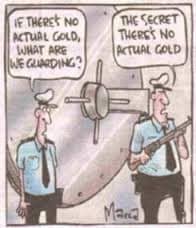 The source of this 1974 story was Louise Auchincloss Boyer, 59, an executive assistant to members of the Rockefeller dynasty for 30 years. Three days after trying to protect the American people from yet another Rockefeller scam, Louise “fell” to her death from her 10th floor apartment in New York City.
The source of this 1974 story was Louise Auchincloss Boyer, 59, an executive assistant to members of the Rockefeller dynasty for 30 years. Three days after trying to protect the American people from yet another Rockefeller scam, Louise “fell” to her death from her 10th floor apartment in New York City.
According to Bill Still,
“There is probably ZERO ‘good-delivery’ gold (.995) in Fort Knox. Just as with other issues in this day, U.S. Treasury could completely embarrass us critics any day of the week by throwing the doors open to the press and showing mountains of good-delivery gold . . . An annual physical audit of U.S. gold reserves is required by law. However, the last time one was done was 1957.”
Besides confiscating the American people’s gold twice, many countries allegedly maintain some of their gold treasures in New York City, at the vaults of the Federal Reserve Syndicate. The Syndicate drags its feet on any foreign central bankers’ request to repatriate or even audit their own country’s gold, thus raising suspicions [23] that most of that gold had been stolen too.
An Ever-Growing National Debt
In this upside-down debt-based monetary system of ours [3, p. 33), “in order to keep money in the system, some major player has to incur substantial debt that never gets paid back; and this role is played by the Federal Government.” In other words, the current system creates an ever-growing national debt that cannot be paid back—unless and until the bankers are removed from power.
We are all debt slaves, and will continue to be as long as the banking scam continues. Prof. Lawrence Kotlikoff says that, by 2013,
“the true debt is $205 trillion; the official debt is only $17 trillion. So, most of the problems we’re facing, most of the debt we have, the vast majority of it is off the books and Congress has done bookkeeping to make sure the public doesn’t see it. . . . This is more or less a conspiracy to . . . keep ourselves and our kids in the dark about what the politicians are really doing.”
Kotlikoff’s honest figure means a debt of roughly $1.7 million for every American household. No wonder they must resort to creative bookkeeping! This racket cannot go on forever, of course. So they will either print the needed money, creating hyperinflation, or they will simply stop such things as social security payments. Either way, if the bankers continue to rule us, most of the debt will never be paid.
The bankers tax you to the hilt in your working years, telling you that you are not responsible enough to save the money yourself. They then steal the money using Orwellian doublespeak (e.g., tax cuts, defense budget, bailouts), driving you to poverty or even destitution. Then they try to justify the theft by telling you that this money was not yours to begin with, but a mere “entitlement.”
This is the kind of heartless exploitation Andrew Jackson must have had in mind when he described the banking Syndicate as a “hydra-headed monster eating the flesh of the common man.”
Bailouts
Bailouts constitute yet another way of transferring millions, billions—and nowadays often trillions—from the people to the bankers. If we could just manage to stop that one scam, the net worth of each one of us would be a multiple of what it is now.
James Corbett [4]:
“As a century of history and the specific example of the last financial crisis shows, the Fed was used as a vehicle to bail out the very bankers who own the Fed banks in the most obvious example of fascistic collusion imaginable. . . . JP Morgan Chase chief executive . . . was also a member of the board of the New York Fed during the period that saw $391 billion in Fed emergency lending directed to his own bank. In all, Federal Reserve board members were tied to $4 trillion in loans to their own banks. These funds were not simply used to keep these banks afloat, but actually to return these Fed-connected banks to a period of record profits in the same period that average workers saw their real wages actually decrease and the economy on main street slow to a standstill.”
Edward Griffin [6] comments:
“The game called Bailout has been played over and over again in the rescue of large corporations, domestic banks, and savings-and-loan institutions. The pretense has been that these measures were necessary to protect the public. The result, however, has been just the opposite. The public has been exploited as billions of dollars have been expropriated through taxes and inflation. The money has been used to make up losses that should have been paid by the failing banks and corporations as the penalty for mismanagement and fraud.”
A former Secretary of Interior of the Reagan Administration recalls a cabinet meeting [6]:
“In amazement, I leaned back in my large, leather chair, only two seats from the President of the United States. I realized that nothing in the world could keep these high government officials from scrambling to protect and bail out a few very large and sorely troubled American banks.”
Mark Pittman, a mainstream financial journalist given the rare privilege of sharing a few scandals with the public, showed that the Federal Reserve Syndicate and its owners underhandedly stole trillions of dollars from the American people. Another inconvenient story of his pointed to “former Treasury Secretary Henry Paulson’s involvement in creating the subprime mortgage crisis when he was CEO of Goldman Sachs.” By 2009, Pittman had enough of secrecy, lies, and grand thefts and took the most unusual step of suing the Federal Reserve.
Mark Pittman died a short time later, aged 52.
Boom and Bust Cycles
James Corbett: [4]
“We now know that for centuries the people of the United States have been at war with the international banking oligarchs. That war was lost, seemingly for good, in 1913, with the creation of the Federal Reserve. With the passage of the Federal Reserve Act, President Woodrow Wilson consigned the American population to a century in which the money supply itself has depended on the whims of the banking cabal. A century of booms and busts, bubbles and depressions, has led to a wholesale redistribution of wealth toward those at the very top of the system. At the bottom, the masses toil in relative poverty, single-income households becoming double-income households out of necessity, their quality of life being slowly eroded as the Federal Reserve Notes that pass for dollars are themselves devalued.”
“Worse yet, the fraud itself perpetuates Alexander Hamilton’s persistent myth that a national debt is necessary at all. . . .
“This cabal bear allegiance to no nationality, no philosophy or creed, no code of ethics. They are not even motivated by greed, but power, the power that the control of the money supply inevitably brings with it.
“This is why the bankers and their partners in government and business conspired to bring about the 2008 crisis. Not for the pursuit of money, but power. In the same way the bankers used the Panic of 1907 to consolidate their control over the money supply, they hope to use the 2008 crisis and subsequent panics, which they themselves have created, to consolidate their political control.”
Griffin [6] describes the Panic of 1834:
“When the Second Bank of the United States was struggling for its life in 1834, Nicholas Biddle, who controlled it, set about to cause as much havoc in the economy as possible and then to blame it on President Jackson’s anti-bank policies. By suddenly tightening credit and withdrawing money from circulation, he triggered a full-scale national depression.”
The Great Depression provides yet another example of a boom follows by a bust. It caused a greater loss of American lives than all of America’s wars—combined. Even Rockefeller puppets like Alan Greenspan [cited in 6, p. 474], Ben Bernanke, and Milton Friedman agree that it was inadvertently caused by the Syndicate. But that too, as Corbett notes, is a lie—meant to obscure the monstrous truth that the Syndicate caused the Great Depression, and all other booms and busts since, knowingly and deliberately. “In politics,” FDR said, “nothing happens by accident. If it happens, you can bet it was planned that way.”
Rigging all Markets
Wouldn’t you like to know, just once, whether tomorrow’s stocks [22], bonds, interest rates, foreign currencies, precious metals [22], or commodities are going up or down? Can you imagine how much money you could be making on that single day?
Well, the bankers know, and that is just one more way of enriching themselves at the expense of all other unsuspecting market participants. To make matters worse, they often manipulate markets with the huge welfare checks (bailouts) the people give them.
To keep up the pretense of democracy and free markets, the bankers are occasionally caught by their own cops and media. They then agree to “settle” out of court, pay an infinitesimal fraction of their loot—and keep rigging the markets.
Here is a quote from the mainstream press:
“Everything is rigged . . . The second huge financial scandal of the year reveals the real international conspiracy: There’s no price the big banks can’t fix. . . . You may have heard of Libor scandal, in which at least three – and perhaps as many as 16 – of the name-brand too-big-to-fail banks have been manipulating global interest rates . . . When that sprawling con burst into public view last year, it was easily the biggest financial scandal in history. . . . That was bad enough, but now Libor may have a twin brother . . . suggest[ing] a single, giant mushrooming conspiracy of collusion and price-fixing hovering under the ostensibly competitive veneer of Wall Street culture. . . . It’s not just stealing by reaching a hand into your pocket and taking out money, but stealing in which banks can hit a few keystrokes and magically make whatever’s in your pocket worth less.”
Such scandals are popping now with clockwork regularity. On the day I was revising this article for the last time, the slap-on-the-wrist charade was again in the news:
“The Swiss competition watchdog has launched an investigation into possible collusion in the precious metals market by several major banks, it said on Monday, the latest in a string of probes into gold, silver, platinum and palladium pricing.”
So: Banks rig each and every market. Since they generally know in advance the future direction of most things financial, they can make billions in a single day, buying or selling. Since gambling is a zero-sum game, their ill-gotten gains are our losses.
Wars
War exerts an enormous toll on ordinary people, often separating them from loved ones, maiming them physically and emotionally, or killing them. Wars also pose the greatest menace to our liberties (that is why Thomas Jefferson did everything he could to avoid them in those happy years when he was president). As we have seen earlier, wars also involve tragic opportunity costs: The money spent globally on wars today could markedly improve the quality of life of every human being on earth.
Most wars have been engineered by the bankers and their allies in the banking-military-intelligence-media-academia complex, usually through phoney pretexts or false-flag operations. [24] Modern wars enrich the bankers and their cronies directly. Also, since 1945, many wars have been waged to protect the privileged status of the bankers’ favorite fiat currency (for now, the U.S. dollar).
After the 1913 creation of the Syndicate, warring—following the same logic as inflation and unemployment—accelerated inexorably, to the point where we find ourselves now in an Orwellian permanent war footing. More than $1,000,000,000,000 is spent on America’s wars every year (double the official figures [25]). And even that figure does not include the militarization of the police and the contrived war on terror. Worst of all, the bankers are again pushing humanity ever closer to the brink of an all-out nuclear catastrophe.
The role of the bankers and the profit motive in instigating wars was crystal clear already to Thomas Jefferson:
“The spirit of war and indictment . . . since the modern theory of the perpetuation of debt, has drenched the earth with blood, and crushed its inhabitants under burdens ever accumulating.”
Griffin reminds us of another historical example [6]:
“In the mid thirties a Senate committee headed by Gerald P. Nye of North Dakota investigated the pre-1917 munitions trade and raised a possibility that the Wilson administration went to war because American bankers needed to protect their Allied loans.”
General Smedley Butler, describing the same war [14]:
And let us not forget the bankers who financed the great war [WWI]. If anyone had the cream of the profits it was the bankers. . . . Who provides the profits—these nice little profits of 20, 100, 300, 1,500 and 1,800 per cent? We all pay them—in taxation. We paid the bankers their profits when we bought Liberty Bonds at $100.00 and sold them back at $84 or $86 to the bankers. These bankers collected $100 plus. It was a simple manipulation. The bankers control the security marts. It was easy for them to depress the price of these bonds. Then all of us—the people—got frightened and sold the bonds at $84 or $86. The bankers bought them. Then these same bankers stimulated a boom and government bonds went to par –and above. Then the bankers collected their profits.
Phoney War on Drugs
Banks and the governments they control are heavily involved in the “war” on drugs, supporting both sides of that war. They arrange for weapons and protection for both drug traffickers and the police who are ordered to suppress them, and they provide much-needed laundering services for the money thus made.
Again, there is no such thing as a free lunch—their profits are our losses. We the world’s people pay for the so-called war on drugs, and we pay for the crimes, heartaches, prison stays, and deaths. Non-violent drug users, for their part, risk incarceration and pay higher prices for inferior, dicier, products.
Such an authoritarian system not only shoots itself in the foot [26], but also leaves the door wide open for corruption. For instance, a mainstream article titled “Britain’s Mafia State” contains this passage:
“A former minister in the last government, Lord Green, ran HSBC while it engaged in money laundering for drug gangs, systematic tax evasion and the provision of services to Saudi and Bangladeshi banks linked to the financing of terrorists. Sometimes the UK looks to me like an ever so civilised mafia state.”
For the bankers and their partners in crime, the stakes are high enough to take advantage of their license to kill.
In his 1996 “Dark Alliance” series of articles written for the San Jose Mercury News and later published as a book, Gary Webb wrote that the CIA was involved in smuggling crack cocaine to Los Angeles to achieve two goals: 1. Fund the CIA’s attempt to devastate Nicaragua, topple its democratically-elected leadership, and replace it with a corporate-friendly dictatorship. 2. Spark the “widespread crack cocaine epidemic that swept through many U.S. cities during the 1980s,” thereby minimizing the chances of inner city revolts.
Indeed, “as part of the grassroots backlash generated from Webb’s “Dark Alliance” series, many in the Black Community openly charged that the government, via the CIA’s drug trafficking of cocaine into California, was guilty of a genocidal plot against African Americans.” [27]
Webb also “charged that the Reagan administration shielded inner-city drug dealers from prosecution.”
“There have been reports [28] from reliable sources that, prior to his death, Webb had uncovered even more material related to his original “Dark Alliance’” investigations, and that he was in the process of completing another book about drug trafficking and the CIA. . . . The primary motive behind Webb’s likely murder was to stop him from publishing his next investigative exposé.”
Gary Webb “committed suicide” in 2004, aged 49, shooting himself in the head twice. (When it comes to botched murders, history certainly rhymes. Recall that in just this brief survey, we encountered a six-shooter firing 7 bullets, and two presidents being shot—and then killed by their doctors).
World Conquest
Dr. Stuart Jeanne Bramhall [29] provides a succinct summary of the economic hitman scheme:
“These US-dominated agencies [IMF and the World Bank] operate a mafia-like protection scheme on the global south. Economic hitmen like Perkins pressure leaders of developing nations to accept development loans for massive infrastructure projects (dams, bridges, super highways, etc.) they neither want nor need. If they accept, their economies are paralyzed by crushing debt repayments. If they refuse, they risk assassination or being overthrown through US military intervention or a CIA coup. In nearly every case, the loans go to specific US corporations who build the dams, bridges and super highways.
“In addition to crushing debt repayments, the IMF also impose their notorious “structural adjustment” programs on debtor nations. As a condition to renewing their loans, these countries are forced to open their economies further to US and European investors and enact a variety of austerity measure. These typically include privatization of state-owned utilities (by selling them to US and European corporations) and reduction of public spending by laying off state workers and cutting pensions and food and energy subsidies.”
If the leaders refuse to comply with the bankers’ dictates and manage to escape assassination, the country is physically invaded by a superbly equipped, financed, and indoctrinated military horde. Sometimes the recalcitrant country has a functional democracy, which now the bankers turn into a vicious dictatorship (e.g., post-Arbenz Guatemala). In some cases, the invaded country was already enjoying the pleasures of a CIA-installed dictatorship (Hussein’s Iraq, Noriega’s Panama). Even there, the conquered people look back with longing on the comparatively mild depredations of the dictatorship.
To sow fear in all future foreign politicians and generals, defiant leaders are often incarcerated, tortured, sodomized, or hung. The patriotism of the fathers is then visited upon their children, family, friends, and close associates. The country itself is often turned into a failed state, plagued by planned chaos, destroyed infrastructure, scarred and permanently poisoned landscapes, ethnic strife, beheadings, and displaced, maimed, and traumatized people.
When the bankers run out of weak countries to lay waste to, they pick on China and Russia, thereby bringing the nuclear doomsday clock ever closer to midnight.
Meanwhile, the bankers intensify their attack on their own people, preempting revolt through reliance on servile police, military, mercenaries, disinformation, distractions, contrived terror, ignorance, and fear.
Video: John Perkins at the Veterans for Peace National Convention, 2006
Civil Forfeiture (Cash Cops)
The bankers depend on the police for their safety and for implementing the ongoing transition from freedom to fascism. So cops are carefully screened (for blind obedience, callousness, and scarce critical thinking skills), indoctrinated, and handed a license to kill.
Money plays an important part in this scheme. Cops, to begin with, are paid well. But there are also some indirect ways of augmenting their salaries and assuring their cheerful servility.
One example of this is Civil forfeiture, which, says the Institute for Justice, involves “confiscating items from people, ranging from cash, cars, even homes based on no criminal conviction or charges . . . the police departments themselves are able to keep much of the confiscated money. So they actually have a perverse incentive to steal.
Indeed [30] “Police are free to spend the money they gain from civil forfeitures on anything they want, without fear of punishment. So they spend it on such things as football tickets, trips to Las Vegas, booze parties, Humvees, and surveillance equipment.”
“Once the government seizes your bank account, it provides no prompt way to get your case heard by a judge, and it is up to you to prove your innocence. This is why the vast majority of structuring cases are settled.”
“Current federal forfeiture laws create financial incentives for law enforcement to pursue profit over the fair administration of justice, facilitate the circumvention of state laws intended to protect citizens from abuse, encourage the violation of due process and property rights of Americans, and disproportionally impact people of color and those of modest means.”
In 2002, civil forfeitures netted $322 million. By 2012, they were swiping real money: $4.6 billion.
“For 38 years, Carole Hinders has owned and operated Mrs. Lady’s Mexican Food in Spirit Lake, Iowa. Mrs. Lady’s accepts only cash, which means Carol makes frequent trips to the bank to avoid having large sums of money at the restaurant.
“But in August 2013, the federal government used civil forfeiture to seize Carole’s entire bank account—totaling nearly $33,000—even though she did nothing wrong. Federal law requires banks to report cash deposits larger than $10,000. Since her deposits were almost always less than $10,000, they claimed that she was “structuring” her cash bank deposits to evade that reporting requirement. And now they want to keep all of Carole’s money without even charging her with a crime.”
Police State America
We hear daily about police brutality, militarization of the police, unjust incarceration of millions, Orwellian no-fly lists, [31] arbitrary search and seizures, sunshine assassinations of foreigners and Americans without trials or convictions, and a myriad of laws that are gradually turning the USA into a police state.

The people on the ground were pulled over for an expired license plate and were nearly killed. [32]
Even insiders are obliquely warning us: “Cashless . . . systems would raise everyone’s concerns about privacy and surveillance. Basically the government would be able to start questioning anyone vigorously about virtually every aspect of daily living. . . it would be appalling for the rights of individuals . . . would place everyone inside a precisely defined, monitorable box with defined set of rules of behavior. If local or national governments found themselves in financial crisis, . . . Your balance could be altered.”
As a second example, consider the heyday of the idealistic, naïve, non-violent, miscalled, Occupy movement. The bankers were getting uncomfortable, and sprung into actions not only through their normal channels (CIA, FBI, DIA) but directly through their own mercenaries. Here is how Bancopedia describes this horror:
“Government documents released in December 2012 . . . reveal FBI monitoring of what became known as the Occupy movement since at least August 2011, a month before the protests began. The FBI, the U.S. Department of Homeland Security, local police, regional law enforcement “counterterrorism” fusion centers, and private security forces of major banks formed the Domestic Security Alliance Council (DSAC) to collect and share information about, and to share plans to target and to arrest Occupy protesters. Banks met with the FBI to pool information about participants of the Occupy movement collected by corporate security, and the FBI offered to bank officials its plans to crush Occupy events that were scheduled for a month later. FBI officials met with New York Stock Exchange representatives on August 19, 2011, notifying them of planned peaceful protests. FBI officials later met with representatives of the Federal Reserve Bank of Richmond and Zions Bank about planned protests. The FBI used informants to infiltrate and monitor protests; information from informants and military intelligence units was passed to DSAC, which then gave updates to financial companies. Surveillance of protestors was also carried out by the Joint Terrorism Task Force. DSAC also coordinated with security firms hired by banks to target OWS leaders.”
As well, plans were apparently under way to assassinate some leaders of that movement: [33] Naomi Wolf:
“Banks sat down with FBI officials to pool information about OWS [Occupy Wall Street] . . . and offered to the representatives of the same organizations that the protests would target; and even threats of the assassination of OWS leaders by sniper fire. . . These federal agencies function . . . as a de facto intelligence arm of Wall Street and Corporate America. . . . if you are an Occupy activist and see . . . the “longterm plans” of some redacted group to shoot you, this [officially-released] document is quite the deterrent.”
For many decades, poor and middle-class Americans have been “victimized by a law enforcement system capable of the most venal acts both within the community and in the courtroom, taking away whole lifetimes of innocent people by use of street executions or judicial killings or perpetual incarcerations–an abuse of justice that is beyond measure.” [34]
War on Truth
Corrupt rulers everywhere and always have been hostile to transparency and truth. The bankers are no exception, gradually and systematically monopolizing and corrupting most of our sources of information and crippling our very capacity to think clearly and well.
We have already alluded to a few examples of the bankers’ utter contempt for truth, including assertions that (i) the bankers are honorable people, never rigging markets, stealing, corrupting our morals, smearing, incarcerating, or killing influential opponents, (ii) the Federal Reserve Syndicate was created to stabilize the economy and interest rates and to minimize unemployment and inflation, (iii) the Syndicate serves the public interest, (iv) inflation in 2015 is zero, (v) unemployment in the USA stands at a mere 5.1%, (vi) federal income taxes are necessary to finance government operations, (vii) Fort Knox has more than 8,000 tons of gold, (viii) America’s war budget is $600 billion, (ix) we must spend such vast sums of money on defense” (only twice, they lie, the amount spent by China and Russia combined) to protect our and other peoples’ freedoms, (x) there is no such thing as an odious debt, (xi) the war on drugs is real and serves the public interest, (xii) civil forfeiture is not highway robbery but serves the national interest, and (xiii) poverty, homelessness, depressions, wars, corruption, sunshine bribery, and vast income inequalities are unavoidable or perhaps even good things.
The bankers’ lies and attacks on our very ability to think go back centuries. Upton Sinclair’s The Brass Check [35], written around 1919, can be viewed as one long indictment of the Rockefeller-owned media:
“Our newspapers do not represent public interests, but private interests; they do not represent humanity, but property; they value a man, not because he is great, or good, or wise, or useful, but because he is wealthy, or of service to vested wealth. . .
“The social body to which we belong is at this moment passing through one of the greatest crises of its history . . . What if the nerves upon which we depend for knowledge of this social body should give us false reports of its condition? . . .
“I was determined to get something done about the Condemned Meat Industry. I was determined to get something done about the atrocious conditions under which men, women and children were working the Chicago stockyards. In my efforts to get something done, I was like an animal in a cage. The bars of this cage were newspapers, which stood between me and the public; and inside the cage, I roamed up and down, testing one bar after another, and finding them impossible to break.”
By now, truth is almost entirely absent from the mainstream. As just one example of the War on Truth, consider an unusual article in the left-of-center mainstream press, explaining “how the federal reserve bought the economics profession:”
“The Federal Reserve, through its extensive network of consultants, visiting scholars, alumni, and staff economists, so thoroughly dominates the field of economics that real criticism of the central bank has become a career liability for members of the profession. . . . This dominance helps explain how, even after the Fed failed to foresee the greatest economic collapse since the Great Depression, the central bank has largely escaped criticism from academic economists.”
All this happened because it was planned that way. Griffin [6] provides another example of this gradual process. In 1917, Representative Callaway from Texas took the floor of Congress and explained:
“In March, 1915, the J.P. Morgan interests, the steel, shipbuilding and powder interests, and their subsidiary organizations, got together 12 men high up in the newspaper world and employed them to select the most influential newspapers in the United States and sufficient number of them to control generally the policy of the daily press. . . . They found it was only necessary to purchase the control of 25 of the greatest papers. . . . An agreement was reached; the policy of the papers was bought, to be paid for by the month; an editor was furnished for each paper to properly supervise and edit information regarding the questions of preparedness, militarism, financial policies, and other things of national and international nature considered vital to the interests of the purchasers.”
Upton Sinclair observed: “It is difficult to get a man to understand something, when his salary depends upon his not understanding it!”
Besides direct ownership of the media, book, and movie industries, despite the ever-present threat of assassination of recalcitrant journalists, editors, and directors, there is of course advertising: Well-meaning editors, journalists, teachers, professors, songwriters, movie and TV scriptwriters, cannot be candid about issues of concern to their advertisers. [36]
Rockefeller Medicine
Isn’t it curious that the life expectancy at birth of people born in Spain or Switzerland is 83 years, while in the USA it is 79 (38th place in the world)—even though per capita spending on health in the USA is roughly 3.5 times greater than in Spain (in 2013, $9,146 vs. $2581)? Have you ever asked yourself why a Cuban born today is likely to live as long as her American counterpart, even though the per capita spending on health in the USA is 15 times larger than in Cuba?
As strange as this may sound, one reason for this scandalous state of affairs is . . . the bankers. Long ago, they used their fraudulently- and fractionally-obtained wealth and power to enrich and strengthen themselves even more—and to deliberately undermine the quality and duration of our lives.
James Corbett: [37]
“As Americans . . . wonder how the country became enslaved to the highest healthcare costs in the world, we turn back the pages to look at how the modern medical paradigm came together in the early 20th century, courtesy of the Rockefeller Foundation and their cronies.”
[The healthcare industry came into being] “as a result of a concerted and carefully plotted plan that was laid out generations ago by people with malice of forethought. . . . By taking over the medical industry in 1910 through studies which he made through the Carnegie foundation, John D. Rockefeller emerged as the kingpin of the medical monopoly in the United States. And he now presided over an allopathic system of medicine, controlled through every legislature by accreditation of hospitals, control of physicians, control of medications and which is essentially what we have today. . . . Interestingly enough, the Rockefellers control every major drug company in the world, and when I say control, I mean directly. . . . I think we understand that profit isn’t in and of itself a motivating driving factor for the David Rockefellers and others of the world. . . . America became the most expensive healthcare system in the world . . . through methodical planning over the course of generations by people with almost unthinkable amounts of wealth.”You might want to watch this video, before your next chemotherapy session, or before you visit to a conventional physician, dentist, or pharmacist:
War on the Biosphere and the Probable Extinction of Humanity
Thanks to the bankers and their allies and collaborators, the whole biosphere is now Easter Island writ large. The bankers are not only experts in crippling our lives, liberties, and pursuits of happiness, but also in terminally fouling our own collective nest. In the long run, that is their worst crime. Humanity could one day overcome such horrors as wars, the fractional reserve chicanery, needless poverty, or institutionalized mendacity, but it is doubtful [38] that it could recover from the bankers’ attack on the physical and biological foundations of life itself.
Parting Words
It could probably be said that never in the history of the world have so few managed to find so many scams to impoverish, enslave, and kill so many.
We know we can do better, far better, than being ruled by murderous bankers. We can, for example, nationalize all banks and deprive bankers of the right to confound or bribe almost every politician, judge, general, spook, movie producer, journalist, man, woman, and child in the land.
Or we can, at least until we have real democracy, go back to gold and silver money, with the ratio between them determined by market forces, and with the government’s role restricted to minting coins and preventing such frauds as counterfeit money and fractional-reserve lending.
Ellen Brown [39], for instance, tirelessly reminds us that a public approach to banking, even at the state level, could accomplish miracles:
“The public banking model is simply more profitable and efficient than the private model. Profits, rather than being siphoned into offshore tax havens, are recycled back into the bank, the state and the community.”
Elsewhere, Brown echoes the countless intellectuals and public figures quoted earlier in this report: [3, pp. 447-8]
“Only a radical shift in our concepts of money and banking will save us from the cement wall looming ahead. . . . We own nothing that can’t be taken away. The housing market could go into a tailspin and so could the stock market. The dollar could collapse and so could our savings. Even social security and pensions could soon be things of the past. Before the economy collapses and our savings and security go with it, we need to reverse the sleight of hand that created the bankers’ Ponzi scheme. The Constitutional provision that ‘Congress shall have the power to coin money’ needs to be updated so that it covers the national currency in all its forms, including the 97 percent now created with accounting entries by private commercial banks. That modest change could transform the dollar from a vice for wringing the lifeblood out of a nation of sharecroppers into a bell for ringing in the millennial abundance envisioned by our forefathers. The government could actually eliminate taxes and the federal debt while expanding the services it provides.”
Likewise James Corbett [4]:
“Now, one century after the creation of the Federal Reserve system, we have a choice to make: whether the next century, like the one before it, will be a century of enslavement, or, transformed by the actions and choices that we make in the light of this knowledge, a century of empowerment.”
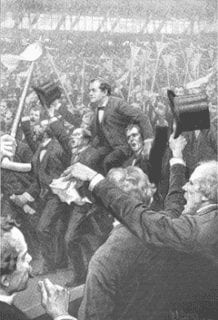
Delegates to the Democratic National Convention (Chicago 1896) carrying William Jennings Bryan shoulder high after he delivered his “Cross of Gold” speech (photo source)
In 1896, William Jennings Bryan said [40]:
“We believe that the right to coin and issue money is a function of government. . . . It is a part of sovereignty, and can no more with safety be delegated to private individuals than we could afford to delegate to private individuals the power to make penal statutes or levy taxes. . . . I stand with Jefferson . . . that the issue of money is a function of government, and that the banks ought to go out of the governing business . . . When we have restored the money of the Constitution, all other reforms will be possible, but until this is done there is no other reform that can be accomplished.”
History shows that Bryan was on the money. Nothing, absolutely nothing, will ever be accomplished in the USA and elsewhere until the people vanquish the bankers.
Notes and References
- Jeff Badyna (2013). America’s Next Bill Of Rights.
- Michael Parenti (2013). “A Terrible Normality.”
- Ellen Hodgson Brown (2008). Web of Debt.
- James Corbett (2014). “Century of Enslavement: The History of The Federal Reserve” (video and transcript).
- Taylor Caldwell (1972). Captains and the Kings.
- G. Edward Griffin (1998). The Creature from Jekyll Island.
- Dean Henderson (2011). “The Federal Reserve Cartel: Freemasons and the House of Rothschild.”
- Rand Clifford (2013). “Time to End the Private Fed.”
- David Graham Phillips (1906). “The Treason of the Senate.” (A series of articles which appeared in Cosmopolitan. The March article is available online.)
- Daniel D. Victor (2010). The Further Adventures of Sherlock Holmes: The Seventh Bullet.
- Charles A. Lindbergh, Sr. (1913). Banking and Currency and the Money Trust.
- Ludovic Kennedy (1996). Crime of the Century: The Lindbergh Kidnapping and the Framing of Richard Hauptman.
- Mike Whitney (2012). “Would you vote for this man?”
- Smedley Butler (1935). War Is a Racket.
- Moti Nissani (2015). “Pillars of American ‘Democracy:’ Cloak-and-Dagger Smoking Gun Evidence.”
- The Liberterian Forum (1971), p. 4
- Bill Drexler (2005). “The most important legal decision ever decided.”
- David E. Stannard (1992). American Holocaust.
- John Williams (2015). “Alternate Employment Statistics.”
- David Bryan (2015). “Einstein, Physics, Gold and the Formula to End Economic Decay.”
- Bill Still (2009). “Fort Knox Gold Scandal.”
- F. William Engdahl (2013). China, gold prices & US default threats.
- Koos Jansen (2015). “Germany Repatriated 120 Tonnes Of Gold In 2014.”
- Moti Nissani (2013). “History: Read it and Learn (Part V of: A Bird’s Eye View of Contrived Terror).”
- According to the mainstream press: “When one scratches beneath the bureaucratic veneer, national security spending is much larger, nearly double the amount US citizens are told.”
- Herbert L. Packer (1968). The Limits of the Criminal Sanction.
- Douglas Valentine (2015). “Narcotics and Covert Intelligence: How the CIA Commandeered the ‘War on Drugs.’”
- Charlene Fassa (2005). “Gary Webb: More Pieces in the suicided puzzle.”
- Stuart Jean Bramhall (2014). “US Dollar Suffers Serious Setback.”
- Devon Douglas-Bowers (2015). “Cash Cops: How Civil Forfeiture Enriched U.S. Law Enforcement.”
- Rebecca Gordon (2015). “How No-Fly Lists are Used to Punish Political Protesters.”
- The Free Thought Project (2015). “How traffic stops for license plates, tail lights, seatbelts can be a death sentence in police state USA.”
- Dave Lindorff (2013). “FBI, Snipers & Occupy.”
- Michael Parenti (2015). “A Long Time for Killing.”
- Upton Sinclair (1919). The Brass Check.
- Ben H. Bagdikian (2000). The Media Monopoly.
- James Corbett (2013). “Rockefeller medicine.”
- Moti Nissani (2015). “The Human Experiment is Probably Coming to an End.”
- Ellen Brown (2014). “The Success of Public Banking: Bank of North Dakota Outperforms Wall Street.”
- William Jennings Bryan (1896). “’Cross of Gold Speech’ at the Democratic Party National Convention in Chicago.”
![]()
 is an organic farmer (in Argentina), a former university professor (in the USA), a jack of many trades, and the compiler of “ A Revolutionary’s Toolkit.”.
is an organic farmer (in Argentina), a former university professor (in the USA), a jack of many trades, and the compiler of “ A Revolutionary’s Toolkit.”.
=SUBSCRIBE TODAY! NOTHING TO LOSE, EVERYTHING TO GAIN.=
free • safe • invaluable




